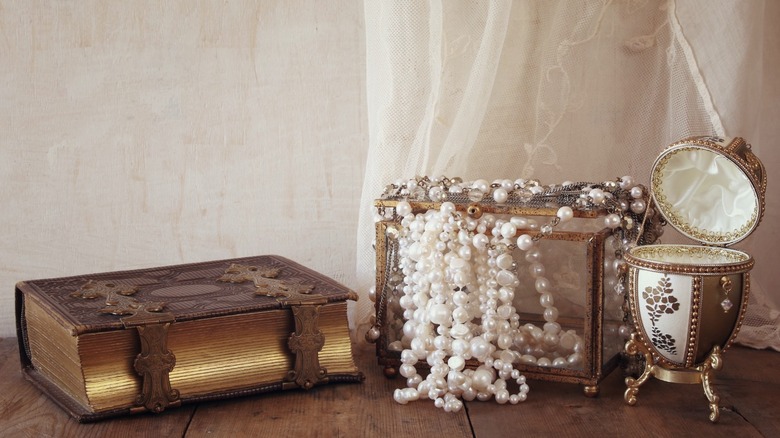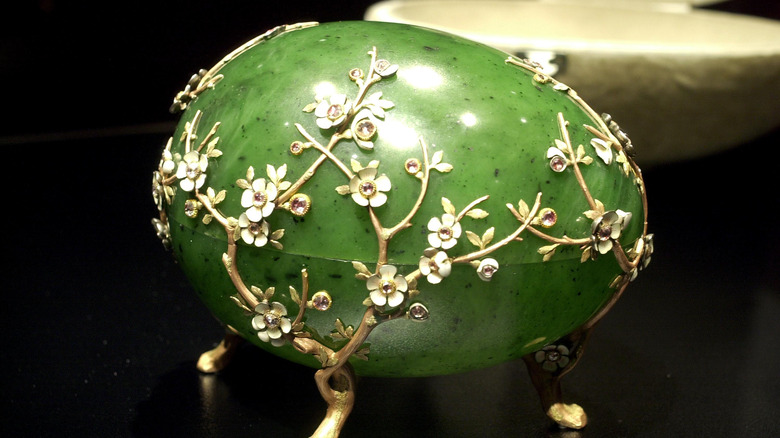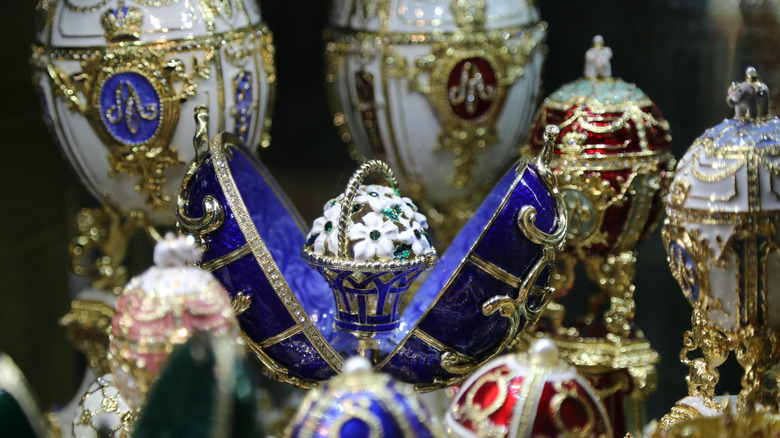The Real Reason We Can't Find The Missing Romanov Faberge Eggs
In January 1917, Peter Carl Faberge was crafting his most valuable piece of annual commission work, an exquisitely-ornamented egg for the wife of Czar Nicholas III (via History). By July 1917, the latest Faberge egg was ready for Alexandra Feodorovna, but it would never be delivered. Russia's imperial palace had been relieved of its luxury goods, and his customer, Czar Nicholas, had been relieved of his head.
The tradition of Imperial Eggs began in 1885 when Russian Czar Alexander III sought out Peter Carl Faberge, the newly-minted proprietor of a luxury jeweler house (via Faberge Land and History), and asked him to craft a uniquely spectacular gift Alexander could offer his young wife. Faberge created a gold-and-jewel-encrusted egg, the first of approximately 50 eggs the Romanov dynasty would commission over the next four decades (via History).
After the February Revolution and the Bolshevik's seize of the Russian palace, the royal family's known collection of luxury goods was taken to the Kremlin in Moscow for storage, then auctioned off in the subsequent decades as the economy fell on hard times (via PBS). Now, the czars' precious collection is scattered amongst extravagant exhibits in art museums, the estates of wealthy Russophiles, and former royals' trusts. Seven eggs, however, are most likely floating around far-less-reputable markets: black or flea, to be exact.
What Are Faberge Eggs?
Faberge eggs, also known as the Imperial Eggs, are legendary objects of proclaimed exquisite beauty and inimitably masterful craftsmanship produced for the Romanov dynasty between the years 1885 and 1917. With the exception of the von Dervis Exhibition in St. Petersburg in 1902, as History and Faberge Research both note, the Imperial Eggs were never displayed to the Russian public.
Of the approximately 50 Imperial Eggs from the Romanovs' known collection, 43 are secured in private collections or displayed in public museums (via CNN). One of these 43 only recently resurfaced. In 2013, as CNN reported, a scrap-metal dealer discovered the Third Imperial Egg at a flea market in the American Midwest. The egg was sold to a private buyer whose identity was not disclosed, according to Faberge Land.
The whereabouts of the seven additional eggs remain unknown to the general public (and perhaps to the Faberge estate itself). Two of the missing eggs are rumored to be ("... or at a certain moment were") in the West, according to a cryptic quote from Faberge expert von Habsburg cited in History. Those eggs, the article contends, are the 1889 Necessaire Egg, last seen in London in 1949, and the 1888 Cherub with Chariot Egg, which was last seen in 1934 at an exhibition at a New York City Lord & Taylor department store.
So where are the Faberge eggs?
After Czar Nicholas III died, the Bolsheviks' "peace, land, and bread" idealism was replaced by Stalin's Cheka, or secret police, (per Brittanica) and the Russian economy collapsed from global depression and a civil war. As the Leninists' "redistribution" dream dissolved into nothing more than state-regulated seizures and the occasional adage about Soviet strength, Stalin began to auction off the imperial treasures, including all but ten of the Romanovs' Faberge eggs (via PBS).
The Western old-money wealthy quickly snatched up many of the former czar's luxury goods according to "Russian Art and American Money" (via JSTOR). The trappings of Russian royalty, and the luxury jewels of the Romanovs, were once again where they had always been — locked away, sometimes in private collections, as elusive as they are useless.
Although seven Faberge eggs have officially unknown whereabouts, it's possible that some of them are "missing" thanks to poor record-keeping by the Kremlin (as noted by History Hit) or at the request of off-the-books discreet collectors to whom they were legitimately sold. Alternatively, the eggs could be well-secured within the precious stockpiles of an art larceny enterprise (some are known to have been stolen at various points, as Newsweek reported), or even, as fate would have it, in scrap-metal bins at midwestern flea markets. The seven remaining Imperial Eggs of the Romanov dynasty are priceless historical artifacts, and the art world is well-aware they are missing. And with an estimated dollar value in the seven-digit range, you can rest assured they're looking, too.


